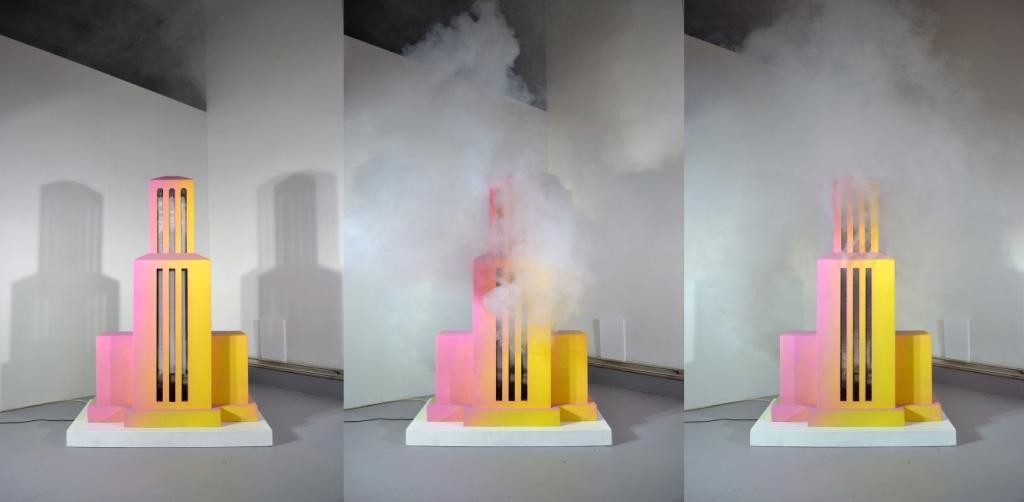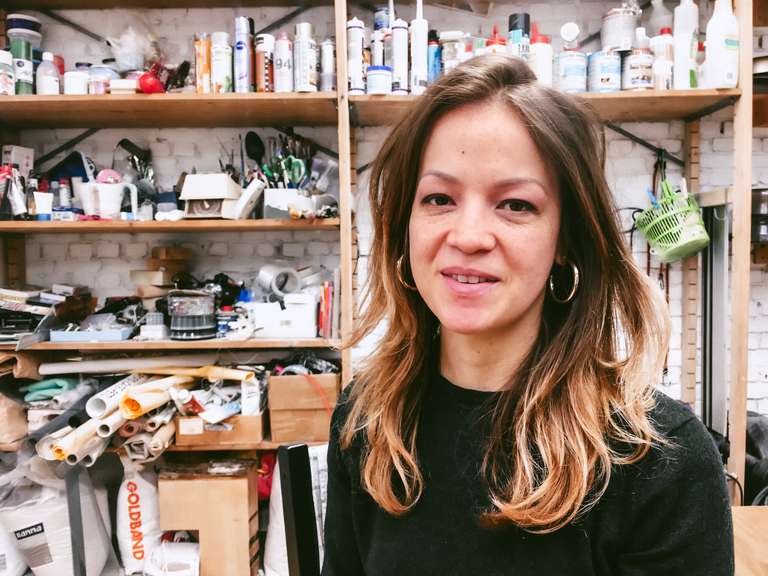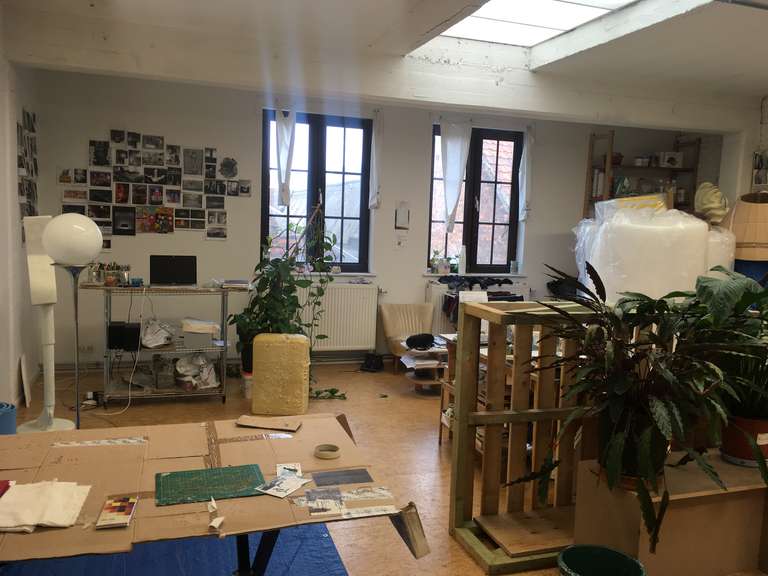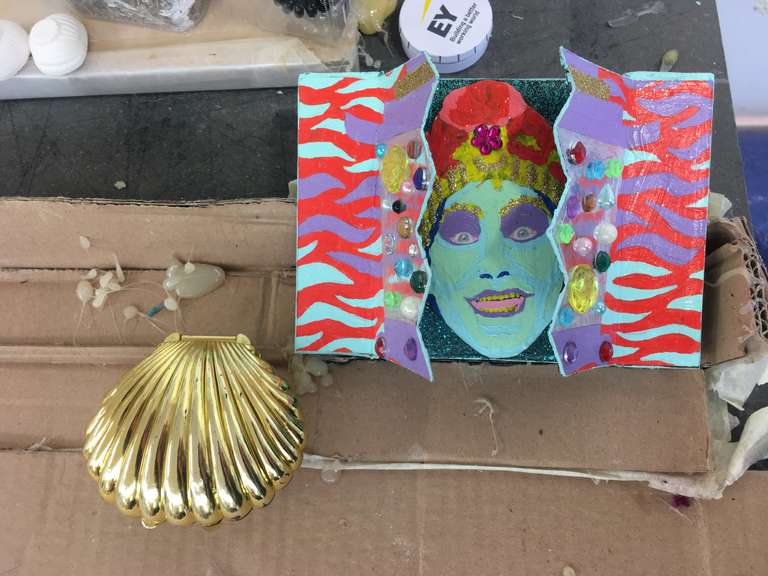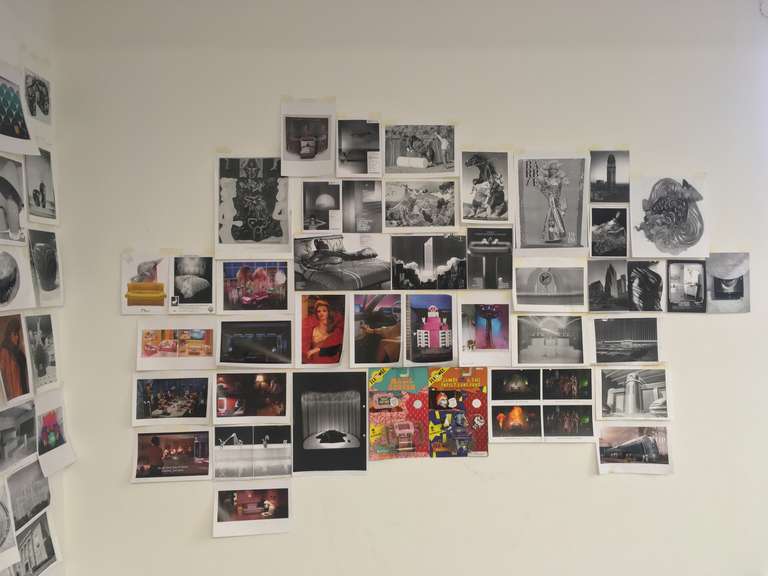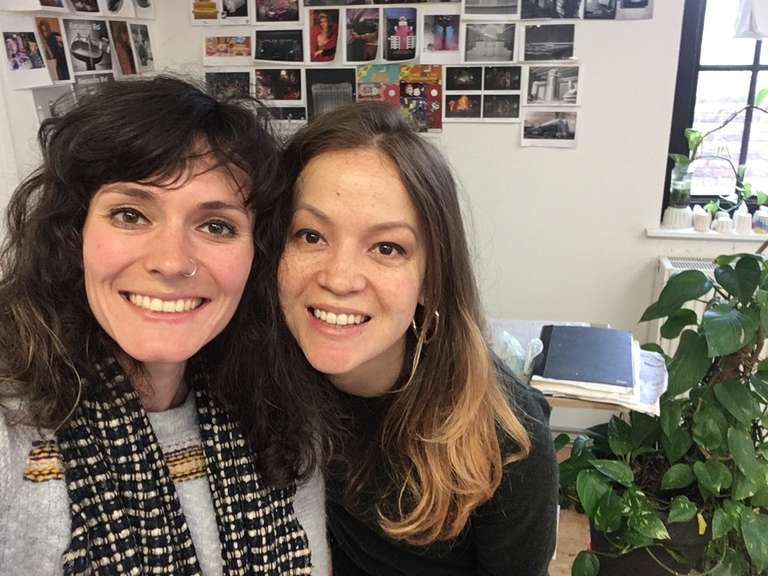We’re on our way to Belgium! Come eat quesadillas in Tramaine de
Senna’s studio with us. She’s a mixed media artist with a
background in architecture, proudly from Vallejo, California.
Nowadays, she loves the light and space in the Antwerp studio she
shares with her husband. It has a band saw and a paint dryer and a
sewing machine and a huge jar of beads that’s great for looking
at. De Senna talks love, absurdity, and the migration of forms. We
can’t bring ourselves to leave.
Some helpful vocabulary & information:
Lichtkoepels - the Dutch word for "skylights"
Korla Pandit
- born John Roland Redd, known as a French-Indian musician from
New Dehli, India. He lived and played music in the USA in the
1950s
Jambi, the genie - one of the characters of the television show
Pee-wee's Playhouse
European art schools Tramaine studied at:
Sint-Joost School of Art & Design, Breda, the
Netherlands
HISK (Hoger Instituut voor Schone Kunsten), Ghent, Belgium
Tramaine on Instagram: https://www.instagram.com/tramainedesenna/
Tramaine’s website: https://sites.google.com/site/tramainedesennamfa/
Listen to the episode
Transcription of Tramaine De Senna's interview
Abbreviations
jb: Jozefien Buydens
sv: Svea Vikander
tds: Tramaine De Senna
__
jb: Hello hello and welcome to a new episode of
Art Crush International. I'm Jozefien Buydens
sv: I'm Svea Vikander
jb: And together we take you into the artist
studios of the world. Because these artist studios are just
wonderful places with lots of light, beautiful artworks, comfy
chairs, and lots more. Svea, where are we going?
sv: Today we're going to Antwerp
jb: In Belgium!
sv: That's right. Have you heard of this place
called Belgium?
jb: Uh, yes. I have heard of the place called
Belgium because I'm Belgian, I was born there, I grew up there.
sv: Yeah it's a really nice place you should go
there sometime. But today we are going to visit the studio of
Tramaine de Senna
jb: That's so exciting, can you tell us a bit
more?
sv: Tramaine, Tramaine de Senna is your friend,
jb: It's my friend, it's true, but you can
introduce her!
sv: I'll talk about her, yeah. So your friend
Tramaine de Senna, who lives in your country, Belgium, also has
roots in the Bay Area and she's a visual artist. She does
sculpture and textile work. And you can find her on Instagram at
@tramainedesenna. [spells out] And yeah, she's really wonderful
and she has a studio in Antwerp and she can also talk about her
experiences in the Bay Area as well. So we're gonna get a really
interesting compare and contrast today.
jb: I've been really looking forward to doing
this interview with Tramaine so, we'll have a blast.
sv: That's right
jb: Ok
sv: The ceiling can't hold us
jb: No, they can't, they can't. Shall we hop on a
plane, to see Tramaine?
sv: Let's go!
tds: I'm Tramaine de Senna, an artist living in
Antwerp, Belgium. But I'm proudly from Vallejo California.
jb: I drive the car to Tramaine's studio, which
is located in Deurne, one of Antwerp's suburbs. Even though I only
need to drive for 35 km, it takes me almost 2 hours to get there.
As everyone in Belgium knows, Antwerp has a huge traffic problem.
So I should have seen this coming. I park the car in the parking
lot and go look for Tramaine.
There are a few studio spaces on the property, as well as a beer
cellar. Two employees are standing outside the shop looking at me
suspiciously. I can see them thinking Who is this woman and why oh
why is she carrying around a huge old fashioned cell phone with a
fluffy hat. Note: the old fashioned cell phone? That's my
recorder. And the fluffy thing on top? That's the windshield. So I
don't catch loud windy noises when recording outside.
I feel like I'm being watched so I smile, nod to say hello and
keep on looking. When I can't find the entrance to Tramaine's
studio, I give her a call.
tds: (over the phone): this is Tramaine!
jb: Hi Tramaine, this is Jozefien. Um, I'm here.
tds: Hi, I'm gonna come right down and find ya.
jb: OK perfect, see you soon!
jb: Oh, hi hi!
tds: Where'd you park?
jb: Oh right there, is that alright?
tds: Yeah yeah yeah, nice to see you!
jb: Oh yeah, nice to see you again, too.
We walk up the stairs to the first floor and enter Tramaine's
spacious studio on the right.
wow, my god this is a big space.
tds: I think we're lucky. Because I don't think
all the spaces have this kind of light, ceiling.
jb: Oh yeah yeah yeah, yeah that's good. How do
you call it in English? Lichtkoepels?
tds: Skylight! I'll show you what we have.
jb: Before we drive into our studio tour,
Tramaine offers to cook us delicious quesadillas because it's
already after lunch time.
You're so sweet. I'm here to interview you and I'm getting food
instead.
tds: But isn't that what artist studios are like,
jb: consequently, we cozily chat our way through
the afternoon and almost forget we have an interview to do! Let's
get to work!
Well mostly we start at around 10 and then it's finished around
noon.
tds: Oh my. You can start, I'm just gonna like
cook these while I'm...
jb: No, that's alright.
[music]
tds: This is the studio,
jb: yay!
tds: Thanks for coming
jb: sure, thanks for showing me around
tds: Yeah you're welcome Like, I have a lot of
art stored against the wall here
jb: we're looking [duck down more] at some
wrapped artworks on the right when entering Tramaine's studio
tds: very large sculptures, large wooden panels
and frames from other artworks. I think we're gonna throw away
some stuff.
jb: Oh, really
tds: Yeah, and there's also paintings from other
people, too. So that's nice.
jb: Moving forward, we arrive at the first of
many of Tramaine's work stations.
tds: tools and a machine for drying paint which
is pretty handy and a—
jb: Which one?
tds: This one, it's pretty handy, yeah yeah, it's
great. It's something that you need for a studio but if you're at
home it would eat up your electricity, you know? It's very
practical. That's a band saw and I remember at Berkeley when I was
there, there was a picture of a bloody finger detached with a
little string in between it, like some kind of organ because it
was like, "Do not,—watch your fingers."
jb: Important
tds: Yeah very much so. So that thing can take
stuff off. So, next to the tool box just like a large work table
with a lot of junk on it right now.
jb: So this is the spot where you work?
tds: actually I work across from it, I have more
tables
jb: Oh wow wow wow
tds: yeah, different media. So this is like,
crushing things or painting stuff. This table, taking things
apart, yeah you see a whole bike chain. I gotta clean it up. Yeah.
[music]
tds: But also a small kitchenette because when
you're working for a while or if you need to make glue out of
flour salt and water, it's handy to have a hot plate. The studio
came with the refrigerator and microwave too, so it's a pretty
handy thing when you wanna put in long hours, it's nice to feel
comfy actually. So yeah that's what you see and next to all of
that is plenty of book supplies, just tools.
jb: Yeah, it looks very organized.
tds: Yes! You know you need a little bit of
organization so you can cut loose with making art.
jb: Do you wanna show your other work table?
tds: Yes, so a little turn, this is another table
that I use for fabrics, fabric work , sewing, maybe painting small
objects. It's like a dry table. And it has cardboard on it right
now because cardboard is really great, accessible, I can find it
on the street but it's just a really great surface to work on if
it's clean. So I'll just put out a cloth and then I'll do ironing
and stuff, for working with fabrics that cannot get dirty. It's
always this spot. This spot is always a very clean spot, you can
make objects and keep it kind of pristine.
jb: And there's a huge jar with colourful beads.
tds: Yes, yeah, um, it's great to look at. I
haven't incorporated it in my art yet. Oh wait actually I made a
little art piece on the wall with some of these rhinestones but
um, I really enjoy some of these colour combinations because they
remind me of toys from when I was a kid. Barbie and the Rockers,
Barbie had her own rock group...
When I look at her clothing or her tools, little guitars and
stuff, they had really great colour texture fabric combinations.
For instance like a neon green with a magenta and maybe some
yellow in there. So with some of these rhinestones I bought them
just to have fun with it, and can I show you over here?
jb: Tramaine takes me to another work station on
our left to show me one of her artworks.
tds: So I made this 3D card. There's actually a
second one out there that I gave to my lawyer. But I use the
rhinestones to accentuate this card which is Jambie the Genie and
Jambie is a character on Pee Wee's playhouse, a great TV show for
children which came out in 1987 and it went until 1991 but um I
love the character Genie because it's the only character on the
show which is not an animal come to life or a piece of furniture
that has come to life.
It's its own thing, something supernatural. And it's really great
to think of this thing, this entity that allows you to make wishes
and maybe they can come true. The whole show is imaginative and
creative. But this one character is just -- it kind of looks
creepy, the card I made, the rhinestones but it's also a little
surprising reminder.
jb: and it's very sweet. and the head turns
around
tds: yeah the head can turn but maybe one day I
can make it into a brooch somehow. But yeah, that's jambie's head
because it's a head in a box and when you say something like
'wish' the box opens and then he starts talking.
jb: And there is also this golden shelf
tds: The golden shelf?
jb: No, the golden shell, the golden shell
tds: The golden shell, yes, a girl friend of mine
who's also an artist, a painter, gave this to me at the opening of
the last show I had, "Supernatural" in Antwerp. She got it at a
vending machine, it had a toy in it but I guess she gave it to me
because the chair objects I made for the show reminder her of this
scallop!
jb: Oh, I can see that
tds: Yeah yeah, I love it actually I love
scallops because it's like the little mermaid—Ok, all these things
going back to toys, I'm revealing all my influences but that's
okay.
jb: Toys, that's important
tds: yeah yeah
jb: Oh and this, there's another desk in the
corner?
tds: Yeah, there's a lot. But which one should I
tell you about? Like this is the boring one, that's the exciting
one.
jb: Let's go to the exciting one.
On the wall in front of us, hangs Tramaine's collection of
photographs that serve as her inspiration
tds: I'm sure everyone collects images, or things
that intrigue them somehow. I remember doing that in high school
but also at Berkeley in my architecture studio but even now I
still collect images. I hang them up above the wall to think about
stuff. And they actually influence me to make objects.
But what I find, I would like to transfer the aura that these
images have into an object. And that's, that's kind of like the
first parts of making art for me. So yeah, it's uh, I just collect
theses things that alternate between civilization, these monuments
of civilizations and also home decor, or cozy things, or movie
sets, or objects or toys.
jb: It's nice!
tds: Thank you.
jb: Do the pictures change over time?
tds: Some pictures I add to and some I take out
but then some I keep with me for a long time. Also, images from
the Wizard of Oz I've been keeping with me for the past 8 years
also. Because my father likes that film, it's an influence for
people but also just aesthetic-wise, it's beautiful, it's
monumental, it's made in the late '30s, and the character Dorothy
going on a journey, which people can relate to, going on a journey
whether it's physical or not.
But her being surrounded by these three characters -- these male
characters -- but they're actually symbolically different facets
of her, you know? But in order to show a multiplicity of being the
storyteller shows it in different characters. So I really like the
idea of a journey somehow and the mystery within people.
And then, yeah, new images come in. But roughly throughout the
years, I've paid attention to my archives and they just basically
stay the same. And they're images that either I've taken or that
I've found, took photos of, or things that I've found online too.
It comes, they come back to life. Where they're being reprinted
again or scanned, or printed again, or living in my computer. And
then again, we have some toys here also
jb: Oh yeah, here he is, right?
tds: Isn't that amazing? Because my auntie,
whenever my sister and I would visit her house with my uncle, she
had all these tchotchkes in her cabinet and one of them, she would
have all these toys from PeeWee's playhouse and you couldn't touch
them but you could look at em, so it was like amazing, I'm sure
when I go to see her she will still have those toys and I'll stare
at them.
jb: Now that the studio tour is done, we set up
at the kitchen table to continue our interview.
What do you like about the studio space you're in now?
tds: Oh my gosh what do I like about it? I love
the fact that there is light coming in from the ceiling and you
and I were talking about that. Like um, skylights? But I forgot
how you say that in Netherlands?
jb: Lichtkoepels
tds: [repeats] That's what i love about it. And
I've always wanted that, in the back of my mind wherever I've
gone. I've always wanted to have really great natural light
somehow. So I am very lucky to have this studio with
lichtkoepels in the ceiling. So I like that and I like
the fact that there are other people here, in this building. Other
artists as well.
When I open the windows I can hear them, which is cool. But also
when I open the windows there are all these, there are many
rooftops that I can see. And it's kind of like in the back lot of
the streets so you have—it's funny how things are set up over here
in Belgium. You have the facade of houses and the entrance way of
houses and stuff. But when you look closely between spaces you can
see that there might be interior courtyards. Or maybe in this
courtyard there's a supermarket.
But in this case there's also this back story of how people live.
You see the interiors of people's houses. Not here but in other
spaces. But one of these days what I'd like to do when I open
these windows is to actually build a physical bridge -- it's a
maybe 6 foot span to the next rooftop. And my neighbours can
easily go onto these rooftops but for me there is corrugated clear
roofing that shows what is underneath, which is like a beer
cellar. So there is no way that I can climb onto this roof and
jump onto the other roof.
Then when I don't make art I can sunbathe! In the privacy of not
many people seeing me, which is great.
jb: If there was one thing you could change about
the studio, what would it be?
tds: good question! I would raise the roof, like
uh, make the ceiling higher. Which is impossible because this is
all poured-in-place concrete. But having high ceilings is so nice,
it's just a nice feeling. And it's really hard to find. You can
find it in fancy chic buildings but not in studios so much. But
when you do it's really great, it's a great feeling.
jb: would you store more?
tds: [chuckles] Yeah I know, huh. And that
becomes an excuse to store more crap and art! Yes Josie, thank you
[laughter], yes I would collect more things to store, yeah yeah.
Yeah maybe, build higher shelves and store things, I guess. Yeah.
[music]
tds: The first thing, as a child you start off
creating things and for me I just enjoyed it and it just stuck.
And all throughout my schooling my classmates always encouraged me
and my teachers did too. And my father was always concerned
because he has this idea that artists always make money when
they're dead which yeah, it happens! My mom always supported me as
well.
My dad was wanting me to be more well-rounded so when I went off
to college that, you know, it's this kind of immigrant idea that
you must work hard, study hard, and go to university to get a
good job so you can support your family. So I followed through
with architecture but I also studied art and I went into
architecture but I always wanted to make art, and I always did,
but there was one person my dad knew.
It was the mother of his friend named Nancy, [name]. And she was
the first person I ever met who was extremely cultured. She passed
away a few years ago. She would have been maybe 80 now. She
married a doctor and then eventually, she was also married to a
lawyer, but she lived in San Francisco on Divisadero, and her
neighbour below her was former governor Jerry Brown, you know what
I mean? She was super high class.
But she, I don't know, she liked my sister and I. She introduced
us to SF MOMA when we were kids. I mean, I remember she took us
there and I saw Jeff Koons' Michael Jackson With Bubbles statue,
and I think it was an exhibition, the main exhibition there was
about drawings from kids who were abused, sexually abused, and I
remember seeing her cry. And I never saw Nancy cry or be so
emotional but that was pretty cool to see someone cry, viewing
artwork, especially someone like her.
But she was quite a figure for me. And my mom always gave my
sister and I play dough and whenever we would visit my mom we were
always making stuff or sewing things. So it's just always stayed
and it's just been a path of how to find my way so I can make art.
You gotta do all these other things, you gotta go to school for
other stuff and take jobs or whatever. But the main thing is
always because I need to make art. I need to go this way because I
have to make art.
[music]
jb: You went to art school from university onward
or were you also in art school in high school?
tds: In high school we had art classes and stuff
but I went to the University of California at Berkeley and so I
did a simultaneous degree, I studied architecture but I was also
in art. The silly thing was because I was in both programs, I
couldn't identify with either one and I always thought well, I
will never be an artist but I'll just make stuff. I didn't know
how to dream.
But then afterwards when I got out and got these desk jobs, I
really wanted to pursue art but I just thought I couldn't because
there was no way to make a living. I worked for about seven years,
working in various jobs. And I had enough money saved up to go
back to school. I wanted to go to art school but I couldn't do it
in the States because for me it was just a little bit too
expensive at the time, and I also wanted to get out of the country
for a bit just to see what was going on outside the Bay Area.
I was trying to become fluent in German for the longest time, so I
could go to art school in Germany because I had exposure to
Germany for a while and I really liked their schooling and the
people who were there, it just—the price of food and
transportation and all that stuff was really nice, and kind of
modest. I was in Berlin in 2009 and I met some Dutch artists. And
at that time I had finished my job at a magazine and I had applied
for a residency because I was thinking, "Well why not," you know?
"I need to try it." So I found a residency in Berlin.
And I met an artist duo and some of their friends and I thought,
"OK, they came from the Netherlands. Where is this country? And
how did it produce such quirky and amazing artists?!" So I decided
yeah, I should go to the Netherlands for art school and it turns
out they had programs in English as well. I studied at Sintyos (?)
this was in Brega (?) in Surtoganbox (?) that's in the South of
the Netherlands.
So I got my Master's there and right after I was accepted into an
art institute in Belgium. In Ghent, the Hogha (?) Institute for
KjonKunsten (?) Which was actually part of a two year program
where they actually, they give you a studio and you have access to
people in the art world, mostly in Belgium, other artists or
curators, or directors and stuff. So after the [HISL?] I didn't
know whether to stay in Belgium or to go back to America and I
actually did go back to America but some stuff happened so for now
I'm still in Belgium. I'm in Antwerp now.
[music]
jb: I guess I also wanna ask: how has moving to
Europe changed y9our art practice? And if so, how did it change
it?
tds: That's a good question. When I look back at
my body of work, the work I've produced, it was always kind of
changing. Because I was trying to experiment with different media
and usually the thoughts were always the same. But I chose to come
to Western Europe because I needed that space of reflection
somehow. Just to not only think about who I am or the country I
came from, but just space.
I had this Euro-centric idea when I was in the States that I have
to go to Western Europe because they must know their stuff. You
have the Italians with the high renaissance, or the basic
architecture or art history, or even architecture history classes
I took at Berkeley always revolved around Western Europe somehow.
I mean, it did kind of touch up on the Asias and the Middle east,
and a little bit on Africa, not much about South America at all,
but it was really Euro-centric.
So I thought "OK, that must be where I should go. They must know
better somehow." It's funny because even without trying, when I
meet people they say, "Ah, your art looks very American or very
Californian because there's so much colour in it."
And um, how has my art changed? Hmmm it just always continues to
change. I think if anything, I still, my mind is still in America.
Even when I was getting critiqued over here, a lot of the issues I
was trying to examine were American issues. So it was kind of hard
to get feedback because there aren't many Americans or people from
the Americas to give me feedback that I needed at times. But also
that's fine because it's something larger.
For a while I wanted to examine my own problems or things I was
wondering about. I examined ti in my art but also after a while,
it was like, it's kinda. it's boring, I'm not actually interested
in it because if I were someone else I wouldn't be interested in
it, if that makes sense. Because everyone has a story, but the
story doesn't always have to be heard, you know? So sometimes I
think, "Ah yeah, my story, actually, pshhh, if I was someone else
I wouldn't wanna hear it."
What really makes me interested in other humans is how they
maintain their humanity, how they overcome things. But how they do
it in their own exuberant way. Because for instance—I'll make it
quick—there's this guy named CorlaPandit, and he was this
supposedly really exotic piano player who had televised television
broadcasts of him playing piano on TV in the '50s, I think. But it
turns out this guy, CorlaPandit, who had a head wrap and a jewel
on his forehead, he said he came from somewhere in India, at that
time, it was accepted in America because like, "Oh this exotic
guy, who knows where India is?" I mean, people weren't used to it.
So he introduced to this large audience, mostly homemakers at home
in the afternoon, he showed them this exotica music. He maintained
this practice until the passed away. He was even in the Ted Burton
film Ed Wood. But it turns out CorlaPandit wasn't Indian! He
totally falsified this. Him and his wife, she was a worker for
Disney, they made this persona up for him to get jobs. He was
actually a Black man! Um, somewhere from Missouri or something.
Roland....Brown or something? Red, reed, Brown?
He adapted this persona because as a black man in the US, there
was this thing called the one drop rule: if you had any drop of
Black blood you would be considered Black, even though you might
have blond hair and blue eyes, if you have any Black history, then
you, there could be ways to discriminate against you. So when this
guy went from Missouri to Hollywood, he could not play as a Black
man. So he changed his name to like, Juan Rolando, to be a Latino,
so he can at least join a union and play music and have gigs and
make money.
But eventually, him and his wife, they made this persona. And as
an Indian man, he was able to show his talent. And I think that's
just like a really amazing story. I mean not only was he talented
but he found a way to go through a system. And it could also be a
little bit offensive because yeah, it's offensive to people who
are Indians. But I think yeah, that's a great story. He went
through oppression but he found his way around it. So I find these
stories amazing. So many things inspire me, too. But yeah, being
in Western Europe, how does it change my artwork? I also learned
that, for me it was like finding out how do people operate, which
is the same anywhere. But like, are people funded by the
government, do they get grants, or are they represented by
galleries, or do they open their own spaces? Like how do people
exist as artists. And I was curious because there seemed to be a
very accessible, quick artist community in the places that I've
been able to live here. In the Netherlands and in Belgium,
somehow.
jb: So you found your art community pretty fast?
tds: Well, um, it took a while. But like when you
know someone and they accept you, you join other communities. Or
you meet a nice person. A lot of big things that have happened to
me have been through other women artists or women curators and
stuff like that. But I guess my point is that for me when I was in
the States, I dunno, somehow I didn't know, I couldn't understand
how the art world worked.
The art world isn't just like the commercial, capitalistic side.
There's all these other things, too. But I didn't know how it
operated, I didn't know who did it or how it ran, or how museums
ran, you know, if you show your stuff there, they're not
responsible for sales and all that stuff. So just going over to
Western Europe it was just really quick for me to like—OK, yeah,
some artists are really great at selling themselves and they can
live that way. But it's a small percentage. You have to earn a lot
of money and half of it goes to taxes. So how do other artists do
it? Some of them become teachers. But it's, it's everywhere and
stuff. But it seemed more accessible. Like, I could find out
quicker how it works. I'm still learning, so.
jb: You mentioned earlier that your mind is still
in America?
tds: Yeah, at times, yeah, unfortunately, yeah.
In America sometimes but like actually it's also here. But a lot
of the things I was trying to figure out because of my family's
history, of them migrating around the world because of economic
reasons, for hundreds of years. My dad comes from China, from
Shanghai, but he's, Chinese, but part Portuguese and Dutch because
of trade, of course. When you think about it, it's like, Yeah,
China was opened up. And through religion and trade. So you have
the Dutch also going over there. I mean, what explains my father's
grandmother having red hair? Red haired woman in China? But yeah,
it was actually a very cosmopolitan place.
My mom's side is mostly descended from African slaves, with Native
American blood. And my mom's father was half English and stuff. So
for me it was always difficult: how do I make sense of this for
myself? Because what culture do you identify with, somehow? We're
American but we're also all these other types of people. And I was
trying to figure that out in art. But I didn't want to ever draw a
line and say, "I'm gonna make art about my Black experience" or
whatever, because there actually was none. It's a mixture of
everything.
And the reason why I didn't wanna draw a line in anything and [I]
focus more on objects—and objecthood—is because as soon as you say
that you are this, then you, it's defining yourself based on what
someone else is not. And sometimes that's very exclusive, it
excludes other people. So for me I'd rather not really say it but
just examine this through objects.
That's how we all exist. I mean, we're surrounded by things that
humans make or that occurs naturally. But we have relations with
objects, also. And for a while, I used to think that it's really
interesting to look at forms because there's all these histories
within it. And with humans also our behavior in a way is a form.
It kind of shows where you're coming from somehow, how you are. Or
your mental state.
[music]
tds: My father, along with his parents, he
emigrated. And this is interesting as well, because a lot of us
kids, the third generation, we're all doing creative things. And
it's something that John Adams, who was a former President, he
wrote to his wife Abigail Adams, "I must study warfare in order
for my sons to study, like naval architecture and engineering, in
order for their sons to study tapestry and painting." And, um,
sewing and all that stuff.
It takes three generations finally to crawl out of poverty or to
assimilate into another land, and to allow for your grandchildren
to make art. To get to the point. Because someone has to crawl out
of poverty, someone has to make money and get an education and
then finally you're free, the next generation can make stuff. To
think, to be able to have that time to think, and then make stuff.
[music]
tds: And actually on my mom's side, her father,
he considered himself "Coloured" but he was born in England to his
English mother, who had red hair, and to a, his Black father. Who
came from West Virginia, which was Fayetteville, a coal mining
town. That man, my great grandpa, Alfonso Pierce, did not want to
work in the coal mines, as a Black man. Or as any man! You don't
want to work in the coal mines, it's terrible work, and terrible
health effects.
So he went up to Ohio and this is around the turn of the century,
the 1900s, to get an education and he decided to jump on a ship
and he fled to England where he met my great-grandma. They got
married, they had a kid (my grandpa) then they emigrated 1926 to
New York, to Manhattan and they lived there and stuff, actually.
But it was very difficult because there was the crash of '29 but
with Alfonso, I actually googled his name and I found him.
He actually had a patent on making a toy in the '50s and it was
really cool! It was like this little rubber band feather
contraption that if you pull something it'll fly. But it was so
cool to see something from my great-grandfather, still alive, in a
US patent, I don't know, system. He was applying for a patent for
this toy. Yeah yeah yeah.
jb: it's beautiful. Your fascination for toys
comes back!
tds: Yeah, I didn't think of that! You drew a
conclusion very quickly, Josie. Thank you very much!
jb: Well I'm not sure if you agree with it.
[laughter]
tds: I didn't think of that somehow. Yeah yeah
yeah, it's very nice!
[music]
jb: Thanks for joining me on our visit with
Tramaine in Antwerp. Remember you can see her work on our website,
and you can follow Tramaine on Instagram. Because this episode
was, yeah, not only travel to Belgium but also travel through
time. And she's been up to some interesting things lately.
sv: Indeed.
jb: Thanks for listening to our show.
sv: It means the world to me.
jb: Who do we have a crush on in our next
episode?
sv: In our next episode we have a crush on David
Wilson. He has a website:
davidwilsonandribbons.com. But he's not on Instagram. And he also does not have a cell
phone. But he's amazing and you can see some work by him on our
website.
jb: Speaking of, that's also where you can sign
up for our newsletter. You'll get some special perk for signing up
for it. But we don't know what yet.
sv: Kisses? Like maybe kisses, air kisses through
the air, like [kissing sounds]
jb: Absolutely! Until then, remember to rate and
review and subscribe and just generally be nice to us and yourself
and everyone.
sv: And follow us on Instagram at
artcrush_international
jb: Love you!
sv: Bye!
